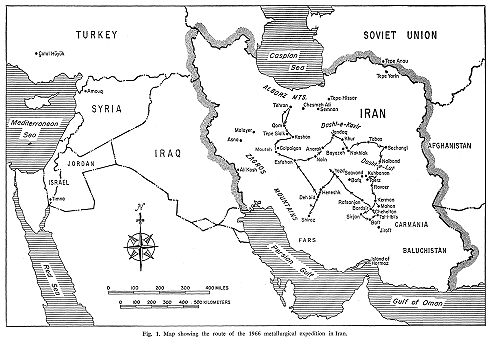Background to the Pyrotechnological collection of 1968
Wertime wrote in 1966, “Forty years ago a number of European countries were vying to be known as the original home of the blast furnace - today the competition has moved in space to the Middle East and in time to the much earlier beginnings of the smelting of ores and metals.” (Wertime 1968, p927)
As scientific archaeological investigations in the Middle East were increasing, the west was learning that a multitude of mechanisms of civilization, from farming technology, to early metals, to writing, early state societies and empires had evolved in and spread from the Near East.
The 1968 Survey, organised by Theodore Wertime, was part of this wave of scientific enquiry. It was funded by the Smithsonian and the National Geographic. Wertime had already been active in the region for several years, both in his professional capacity as Cultural Attaché at the US embassies in Iran and Greece, and in his very own quest for the birth place of ‘pyrotechnology’ as he called it.
Iran had been a focus of Wertime’s studies during the 1960s. In 1961, with the Iran Ministry of Mines, he made a metallurgical reconnaissance of archaeological sites in the North, followed by a trip in 1962, together with Cyril Stanley Smith (A01), which included some experimental work in Yazd (Wertime A02).
Following these surveys, Wertime wrote ‘A favourable juxtaposition of mineral and fuel resources was to be found at sites in the uplands of the Middle East.’ countering ideas ‘expressed by many, the heavily forested zones of the Caspian’ he felt ‘would not have favoured experimentation with pyrotechnology’. He goes on to conclude that the ‘semiarid regions of Central Anatolia and Iran.... Afghan extension of the Iranian plateau’ regions where useful rocks and ores present themselves in a ‘vivid hue’, areas also home to ‘significant stands of two plants...which provide metallurgical charcoal of superlative quality’ would be more apropriate for the emergence of metallurgy (Wertime, 1964).
 |
|
Wertime's Map of the 1966 Survey. (source: Wertime (1968); IoA Source code: E05) |
His next survey in 1966 was in the ‘semi arid regions’ of Iran, covering ‘The Great Persian Desert’. The survey was carried out as an adjunct to the excavations by Caldwell at Tal-i-Iblis (Smith et al. 1967; Wertime A01). They did a rapid and wide ranging survey of old mining and smelting sites in Iran, with the intention of looking for archaeological evidence, traditional lore and pattern of settlement (Wertime A01). A further reconnaissance in 1967 was coordinated with Lamberg-Karlowsky’s field survey, looking for gold, lead, silver, copper, iron and pursuing the mystery of tin in the river basins of the Albourz and Zagros mountains (Wertime A01).
Wertime had gained considerable experience alongside knowledgeable scholars of the region before planning the 1968 survey. His experimental studies and experiences surveying various sites around Iran had given him clear ideas about where he would seek ancient fire technologies, In his 1964 article he mentions ‘Iran… Anatolia ……the Afghan extension of the Iranian plateau’ (wertime, 1964, p.1258), and it was to these three regions that he returned for the 1968 survey, which was going to be the largest and most ambitious of them all.
